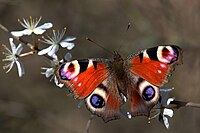
Photo from wikipedia
Simple Summary Understanding how pests and their natural enemies interact dynamically during the growing season and what drivers act on those interactions will help to develop efficient pest control strategies.… Click to show full abstract
Simple Summary Understanding how pests and their natural enemies interact dynamically during the growing season and what drivers act on those interactions will help to develop efficient pest control strategies. We reviewed empirical and modeling publications on the drivers influencing the aphids–natural enemy dynamics. We found disparities between what is known empirically and what is used as main drivers in the models. Predation and parasitism are rarely measured empirically but are often represented in models, while plant phenology is supposed to be a strong driver of aphids’ dynamics while it is rarely used in models. Since modelers and empirical scientists do not share a lot of publications, we incite more crossover works between both communities to elaborate (i) new empirical settings based on simulation results and (ii) build more accurate and robust models integrating more key drivers of the aphid dynamics. These models could be integrated into decision support systems to help advisors and farmers to design more effective integrated pest management systems. Abstract (1) Although most past studies are based on static analyses of the pest regulation drivers, evidence shows that a greater focus on the temporal dynamics of these interactions is urgently required to develop more efficient strategies. (2) Focusing on aphids, we systematically reviewed (i) empirical knowledge on the drivers influencing the dynamics of aphid–natural enemy interactions and (ii) models developed to simulate temporal or spatio-temporal aphid dynamics. (3) Reviewed studies mainly focus on the abundance dynamics of aphids and their natural enemies, and on aphid population growth rates. The dynamics of parasitism and predation are rarely measured empirically, although it is often represented in models. Temperature is mostly positively correlated with aphid population growth rates. Plant phenology and landscape effects are poorly represented in models. (4) We propose a research agenda to progress towards models and empirical knowledge usable to design effective CBC strategies. We claim that crossover works between empirical and modeling community will help design new empirical settings based on simulation results and build more accurate and robust models integrating more key drivers of aphid dynamics. Such models, turned into decision support systems, are urgently needed by farmers and advisors in order to design effective integrated pest management.
Journal Title: Insects
Year Published: 2022
Link to full text (if available)
Share on Social Media: Sign Up to like & get
recommendations!